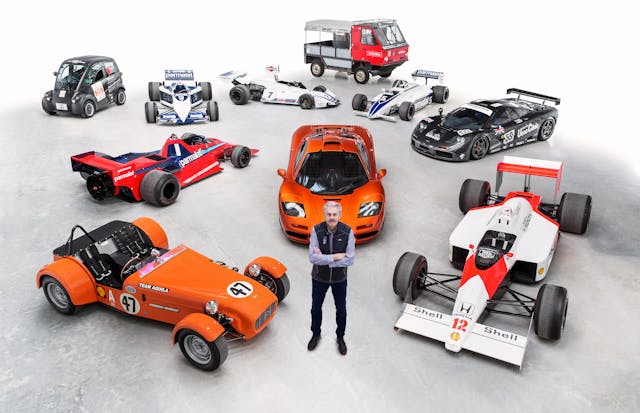How Gordon Murray’s T.50 becomes a 2160-pound, V-12 supercar
Gordon Murray always preferred to save weight rather than push a drivetrain to wild outputs, a process which would require the addition of heavier components to handle the extra power. That’s why he approaches car design from a weight-to-power angle instead of the usual power-to-weight perspective, stressing that “a heavy car can never deliver the dynamic attributes of a lighter one.”
That’s partly the Lotus way of thinking, which leads to engineering solutions that makes cars like the current Alpine A110 so fun to drive. Of course, keeping to such a strict diet takes dedication. To achieve its dynamic goals, Alpine had to create a brand-new, all-aluminum platform, which it paired with a four-cylinder turbo rather than with a larger engine. The French company also sorted through every nut and bolt (just like Mazda did for the ND Miata) to save weight—perhaps that’s why Gordon Murray’s daily driver happens to be a 2018 Alpine A110. However, things get interesting when you realize that Gordon Murray Automotive’s T.50 supercar weighs less than a modern Alpine while packing triple the cylinders, plus seating for three instead of just two.

“Designing a lightweight sports car does not come from specifying exotic materials alone; it comes from a state of mind, from absolute focus and control, and from a deep understanding of lightweight, optimized design,” says Professor Murray.
Back in the early 1990s, Murray’s initial dream was that the McLaren F1 could become a sub-1000-kg (2204-pound) car thanks to its carbon-fiber monocoque and fully-carbon body. However, once McLaren secured BMW’s S70/2 6.1-liter V-12 for the project, all the titanium in the world couldn’t push the F1’s weight below 2509 pounds. In fact, even the ultra-stripped LM models still weighed 2341 pounds.
Almost three decades later, the new T.50 comes with a target figure of 2160 pounds, which, at 980 kilos, is a touch more than the weight of a Lotus Elise. This sub-2200-pound supercar benchmark is partly made possible by GMA’s bespoke powertrain.
The T.50’s naturally-aspirated 3.9-liter Cosworth V-12 will be the world’s highest-revving road car engine at 12,100 rpm. At the same time, this 650-hp aluminum unit weighs less than 397 pounds, which makes it both more powerful and some 132-pounds lighter than the McLaren F1’s BMW-sourced twelve-cylinder. Shredding 22 pounds off the F1 six-speed’s mass, GMA’s “CPA” six-speed manual gearbox made by Xtrac is also a prime example of compact engineering. Even the T.50’s pedal box is 10.5 ounces lighter than the F1’s titanium affair. Try to remember that the next time you order large fries over medium.

The list of optimized components continues with the windscreen’s glaze, which is 28 percent thinner than the industry average without compromising the glass’s structural qualities. That may be a common solution on special-edition performance cars, but Murray’s fanatical mindset goes further for the T.50. Apparently, GMA’s senior design and engineering teams hold a weekly “Weight Watchers” meeting to review the weight of the car and its components. As a result, most of the T.50’s roughly 900 nuts, bolts, and screws have been shrunk, based on how much force each will need to sustain.
GMA says this method has produced countless designs, revisions, trials, and refinements of components. With all that work now done, here’s how Gordon Murray sees the math behind his $2.5-million halo cars:
“In the T.50, every 100 hp only has to propel 150 kg (330 pounds) of car, whereas for the typical supercar (3165 pounds with 684 hp), the weight it has to propel is 40 percent higher, at 210 kg (463 pounds). It is this weight-to-power calculation that drives the development of the T.50, with every component designed and engineered to achieve the lowest starting weight. This focus and control ensures no retrospective weight-saving measures need to be implemented late in the car’s development.
“Weighing just 980 kg and powered by a 650-hp V-12 engine, the T.50 sets a challenging benchmark for rival supercars. To match the T.50’s 663 hp/ton, the typical 1436-kg supercar would need an additional 300 hp. Of course, the 950 hp required to match the T.50 on paper would add cost, complexity, and require larger, heavier components (tires, drivelines, transmission, brakes, etc.) to handle the extra power.
“Today, the enjoyment of driving has been lost as so many supercars only come “alive” at the upper ends of their performance capabilities. Chasing a top speed only adds weight (notably through ever-more powerful engines), so the future of true performance cars lies in shedding weight intelligently.”
Starting off with a carbon-fiber monocoque and body weighing just under 330 pounds combined, the T.50 promises to be an unprecedented V-12 machine. So far, the project also remains on schedule.
Cosworth has completed the three-cylinder engine development program, reporting that power, torque, and emissions targets were all surpassed. Currently, it’s machining V-12 cylinder heads, crankshafts, and engine blocks so that the first GMA V-12 engine can run at the end of June. Xtrac has delivered the first transmissions, which are now being tested. The car’s carbon-fiber monocoque tooling is underway at Formaplex while GMA experiments with the T.50’s now-assembled rear fan unit. Aerodynamic fluid dynamics testing is complete, with fan-assisted aerodynamic performance also reported as better than targeted.
Next up is a the creation of a drivable T.50 development prototype, which should be completed in September 2020.



